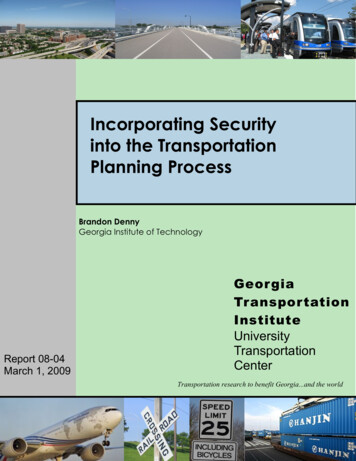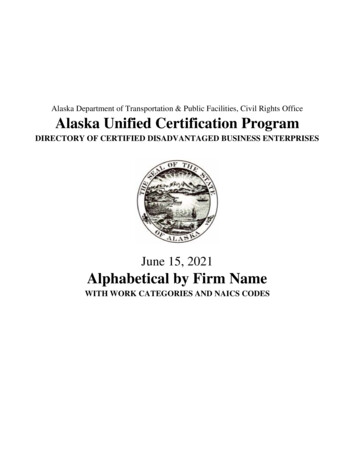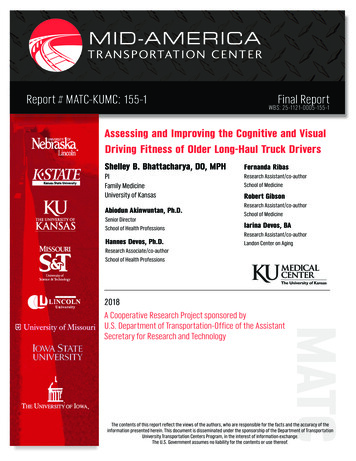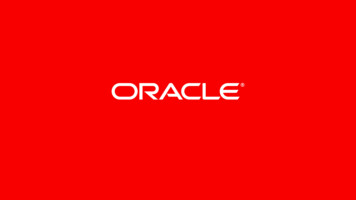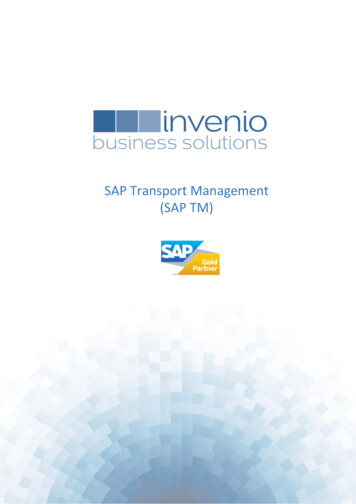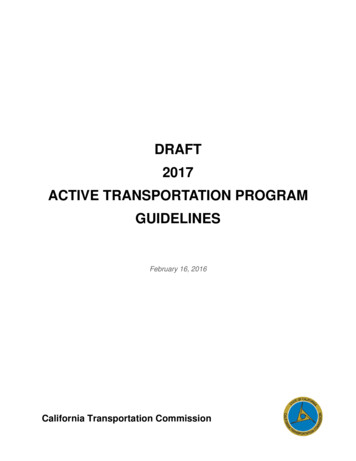
Transcription
BEFORE THEDEPARTMENT OF TRANSPORTATIONWASHINGTON, D.C.Joint Application ofDELTA AIR LINES, INC. and WESTJETUnder 49 U.S.C. §§ 41308 and 41309 forApproval of and Antitrust Immunity forAlliance Agreements)))))))))Docket DOT-OST-2018-0154ANSWER OF ALLEGIANT AIR, LLCTO ORDER TO SHOW CAUSECommunications with respect to this document should be addressed to:Keith Hansen,VP Airport and Government AffairsJohn Pepper,Managing Director of Strategic AnalysisAllegiant Air, LLC1201 North Town Center DriveLas Vegas, Nevada 89144(702) llegiantair.comNovember 20, 2020
BEFORE THEDEPARTMENT OF TRANSPORTATIONWASHINGTON, D.C.Joint Application ofDELTA AIR LINES, INC. and WESTJETUnder 49 U.S.C. §§ 41308 and 41309 forApproval of and Antitrust Immunity forAlliance Agreements)))))))))Docket DOT-OST-2018-0154ANSWER OF ALLEGIANT AIR, LLCTO ORDER TO SHOW CAUSEAllegiant Air appreciates the opportunity to respond to the Order to Show Cause (OSC)in the above matter, particularly the Department’s solicitation of “comments on the details of theproposed divestiture[.]” Order 2020-10-13, Oct. 23, 2020, at 29. While Allegiant takes noposition on the OSC overall, it has comments on the proposed LaGuardia Airport (LGA) slotdivestiture. In Allegiant’s view, revisions to that aspect of the Department’s proposal should beimplemented as set forth below.I.The divested LGA slots should be offered to bidders in two tranches of eightslots rather than one tranche of 16 slots.The OSC contemplates that all 16 divested slots would go to a single bidder.Specifically, at page 29, the Department “proposes that the Joint Applicants divest 16 slots on apermanent basis through a blind auction to one eligible carrier as part of a single trancheconsisting of all 16 slots, or eight (8) round trips.” Ordering Paragraph 4.b is similar. Yet, theOSC reflects no apparent consideration, nor does it contain any discussion, of why the slots
Comments of Allegiant Air, LLCNovember 20, 2020Page 2should not be offered in smaller bundles.1 The Department appears to simply assume a 16-slottranche is optimal.Perhaps DOT’s rationale for bundling the 16 slots is that the Department considers eightround trips per day to be the minimum necessary for a new entrant to establish a pattern ofservice that will benefit the public. But in the case of Allegiant (as well as other ULCCs), that isnot correct. Nor is it in the public interest.Allegiant’s success in operating low-frequency service between smaller and underservedcommunities, on one hand, and world-class destinations, on the other, is well known in theindustry and well understood by the Department. Starting with just a few routes in 2003,Allegiant’s operations have grown to include approximately 100 small or underservedcommunities and 25 destinations using a fleet consisting entirely of mainline aircraft. AllAllegiant flights operate nonstop between origin and destination, with no connecting serviceoffered. Given the popularity of Allegiant’s service and the carrier’s consistent success, therecan be no question that expansion of Allegiant’s service – indeed its unique business model –into new markets, including New York LGA, is in the public interest.Notably in this regard, the Department itself (through the FAA) has made the followingobservation:The term “public interest” encompasses, at a minimum, the policy objectiveslisted by Congress in Section 40101 of Title 49 U.S. Code. Among other things,these include maximizing reliance on competitive market forces, avoidingunreasonable industry concentration and excessive market domination, andencouraging entry into air transportation markets by new carriers.21This omission has occurred despite at least one response to the joint application having urged divestiture toone or more U.S. carriers: “To preserve the competitive benefits intended (and currently provided) by [the 2011 slot]divestiture, the Department should require the 16 LGA slots that WestJet now holds to be re-divested to one or moreindependent U.S. LCCs.” Answer of Southwest Airlines Co., Dec. 11, 2019, at 4 (Docket DOT-OST-2018-0154).2Solicitation of Comments on Petition for Waiver and Other Relief, 76 Fed. Reg. 45313 col. 3, July 28, 2011(emphasis supplied). Section 40101 policy objectives also include “maintaining a complete and convenient systemof continuous scheduled interstate air transportation for small communities” – such as the majority of those servedby Allegiant – and “the continued strengthening of small air carriers” – such as Allegiant – “to ensure a moreeffective and competitive airline industry.” 49 U.S.C. § 40101(a)(11) and (13).
Comments of Allegiant Air, LLCNovember 20, 2020Page 3Unfortunately, inclusion of the divested LGA slots in a single 16-unit bundle will notencourage entry into the LGA market by new carriers, particularly ULCCs – which may verywell represent the only realistic prospect for new entry. It will have precisely the opposite effect,as only those carriers already having a substantial foothold at LGA can afford to take the risk on16 slots in a single transaction. This is especially true in the current, pandemic-depressed travelenvironment. While Allegiant and similarly-situated carriers could build up to eight LGA roundtrips per day over time, they cannot reasonably be expected to do so in one fell swoop.Thus the Department’s proposal, if adopted in its current form, may effectively forecloseparticipation in the auction by prospective new entrants, including well-established competitorssuch as Allegiant –which presumably would be contrary to DOT’s intent. The existing proposalmay also distort market forces if adopted, as the auction will be less “blind” – i.e., its participantsless numerous – if ULCCs are effectively eliminated.Accordingly, the divested slots should be offered to bidders in two tranches of eight slotsrather than one tranche of 16. At four round-trips per day, each eight-slot bundle will be largeenough to independently satisfy DOT’s objectives of “ensur[ing] time-of-day coverage for acompetitive schedule at the airport and provid[ing] efficient aircraft turn times” (OSC at 30).Simultaneously, the use of two bundles will make it possible for the largest number of carrierswith differing business models to participate; and eligible carriers would presumably be free, inany event, to bid on both bundles if desired. In this manner, the tranches will appeal to thebroadest spectrum of new entrants and limited incumbents, best serving the public interest andadvancing all – rather than just some – of the statutory objectives identified above.There is certainly no magic to a 16-slot tranche, given that DOT and FAA havesuccessfully used other slot combinations previously. For example, in the American Airlines/USAirways divestiture in 2013, two 12-slot LGA tranches were offered. Moreover, the OSC statesthat a recipient carrier would be free to lease some or all of the 16 slots to another new-entrant orlimited-incumbent carrier (OSC at 30, 37). Thus it is clear the Department is not wedded to theidea that a single carrier should operate all 16 slots.
Comments of Allegiant Air, LLCNovember 20, 2020Page 4Appended to this answer are several slides we have developed to help inform theDepartment’s decision-making. Attachment 1 depicts average FY 2019 fares at LGA versusAllegiant’s average fare at Newark Liberty International Airport (EWR), where Allegiant hasmanaged to establish a limited pattern of service despite the severe constraints posed by theairport’s IATA Level 2 status. The Allegiant fare at EWR is substantially less than half that ofSouthwest and JetBlue at LGA, and lower still versus the three legacy carriers. It is essentiallythe same as fellow ULCC Spirit and somewhat lower than fellow ULCC Frontier. SeeAttachment 1.Allegiant can generate the same type of public benefits at LGA as it has at EWR byproviding convenient nonstop service from smaller or underserved markets within the 1,500-mileLGA Perimeter Rule. See Attachment 6 for potential Allegiant LGA markets, 52 of which haveno nonstop service of any kind and 50 of which have no nonstop LCC or ULCC service. Thesuccess of Allegiant’s business model has proven that in markets of this type, Allegiant’s serviceneed not be high-frequency to compete very successfully with legacy or connecting service, oralternatively with regional jet operations that, coincidentally, underutilize a scarce resource –LGA slots – by virtue of the much smaller seating capacity of the aircraft. Allegiant aircraft seat156, 177 or 186 passengers with no changes envisioned. And, as shown on Attachment 2, thefew LGA slots held by ULCCs during FY 2019 were used far more efficiently than slots held bynetwork carriers and significantly more efficiently than slots held by LCC or hybrid carriers:ULCCs held only 2.3% of LGA slots, yet carried 11.2% of domestic LGA traffic.As noted above, the OSC reflects no apparent consideration, nor does it contain anydiscussion, of why the divested slots should be offered in one rather than two tranches. Thus, theDepartment’s approach to the issue, which was raised by an interested party in December 2019,3appears unsupported by economic analysis or otherwise. Indeed, on the face of the matter itappears arbitrary and capricious.3See Note 1 above.
Comments of Allegiant Air, LLCNovember 20, 2020Page 5Whether one tranche, as opposed to two, assists a purchasing carrier in enhancingcompetition depends on the type of carrier and the services it plans to operate. It is neitheraccurate nor pro-competitive for the Department to assume a larger bundle would necessarilybenefit a purchaser or the public. Similarly, it is inappropriate for DOT to speculate on howcarriers might utilize any slots they acquire or what their competitive priorities might be. Asexplained above, Allegiant would use LGA slots in a manner consistent with its innovative andhighly successful business model. In turn, that would vindicate multiple statutory objectives andyield substantial public benefits in a manner quite distinct from the Department’s apparentlypreconceived notion.Consistent with the public interest, the divested LGA slots should be offered to bidders intwo tranches of eight slots rather than one tranche of 16 slots.II.Participation in the slot auction should be limited to new entrants and carriersholding no more than five percent (5%) of all LGA slots.In its discussion of slot auction eligibility, the Department begins by stating that its “goalis to preserve the status quo, at a minimum, and thus emphasizing access by new-entrant andlimited-incumbent carriers is appropriate.” OSC at 30. DOT adds, “This approach provides thelargest competitive impact by introducing service from carriers that are more likely to priceaggressively and compete in a robust manner.” Ibid. But DOT then proceeds to undermine itsown goal by proposing that a carrier holding as many as 10 percent of total LGA slots wouldqualify as a limited incumbent.As explained in Part I of this answer, only those carriers already having a substantialfoothold at LGA should be expected to take on 16 slots in a single transaction. Similarly,whether eight- or 16-slot tranches are utilized, opening the auction to carriers already holdingfive to ten percent of total LGA slots – that is, approximately 55 to 110 slots – will exacerbatethe problem. The Department’s proposal amounts to providing two of the “haves” serving LGAa golden opportunity to amass further slots, while the “have-nots” – new entrants and limitedincumbents below five percent – are automatically disadvantaged by having little or no
Comments of Allegiant Air, LLCNovember 20, 2020Page 6foundation of slots to build upon. That, of course, will affect how far the “have-nots” are able togo in bidding.DOT characterizes the proposed 10 percent threshold as “slightly modified” versus thefive percent threshold utilized in 2011. OSC at 30. Allegiant disagrees strongly that amodification whose sole practical effect is to enable United Airlines – a legacy carrier – andSouthwest Airlines – the goliath among LCCs and ULCCs – to participate in the upcomingauction is “slight.” It is anything but that. The respective foundations provided by United’s andSouthwest’s existing LGA slot portfolios mean their participation in the auction will put all otherbidders at an immediate and significant disadvantage. United’s or Southwest’s resulting likelysuccess in acquiring the slots will thwart the Department’s objective of “provid[ing] the largestcompetitive impact by introducing service from carriers that are more likely to price aggressivelyand compete in a robust manner.” OSC at 30.Allegiant and other ULCCs are far more likely to price aggressively and compete in arobust manner than United or Southwest, each of whose obvious objective would be tocomplement its existing LGA service pattern (16 new slots would represent less than one-fifth ofSouthwest’s LGA holdings, and one-sixth of United’s). Indeed, United and Southwest areamong the carriers one or more ULCCs would compete against at LGA. Attachment 4 showsthe effect on HHI Score at LGA if, on the one hand, half of the divested slots were to go toAllegiant and half to Spirit, versus, on the other hand, all of them going to Southwest. Thedifference is striking.The Department has tentatively determined “the ten percent threshold would permit agreater number of participants, providing for a viable auction that would allow for sufficientbids.” OSC at 30-31. That determination is simply mistaken, unless “a greater number ofparticipants” means just two additional participants: United and Southwest. With eligibilitylimited to new entrants and limited incumbents holding no more than five percent of LGA slots,the Department could reasonably expect the following carriers to bid: Alaska, Allegiant,Frontier, JetBlue, Spirit and Sun Country. The sole beneficiaries of raising the threshold to ten
Comments of Allegiant Air, LLCNovember 20, 2020Page 7percent would be United and Southwest. Given that each of them holds more than twice as manyLGA slots as these other six carriers combined, it would be highly inequitable for theirparticipation to be permitted. Such participation would disserve the Department’s “largestcompetitive impact” objective and would not be in the public interest.Attachments 5 and 7 illustrate the type of competitive benefits Allegiant brings to thetable. Attachment 5 reflects the traffic stimulation, effect on competitors’ fares, and stayingpower of Allegiant’s low fares at one of its larger origin points, Cincinnati, over an extendedperiod. Attachment 7 compares Allegiant’s fares at Niagara Falls International Airport (IAG) inNiagara Falls, New York, versus other carriers’ fares from Toronto to the same destinations.That information should be of particular interest to the Department given that IAG-LGA is oneof the markets Allegiant plans to consider (see Attachment 6) and that IAG is an attractivealternative to Toronto’s Pearson International for many Toronto-area residents. As shown inAttachment 7, 45 percent of Allegiant’s passengers using IAG hail from Canada.The Department should make every effort to encourage and facilitate Allegiant’sparticipation in the slot auction by taking the simple steps identified in this answer. This isparticularly true at present given that Allegiant caters to the type of traffic that continues to flydespite the ongoing pandemic – see Attachment 5, showing Allegiant’s continuing offer of 2020seats at a level within shouting distance of its 2019 levels. In the same attachment, compare theprecipitous decline in other carriers’ LGA departures in 2020 versus 2019.Finally, the Department has addressed the extremely remote possibility of lack of interestin the slots: “In the unlikely event there are no bids for divested slots, the slot interests wouldautomatically revert to the LGA slot pool for reallocation by the FAA according to standardpractices.” OSC at 30. As a corollary, DOT could reserve the right to void the auction,reschedule it, and expand the participation threshold from five to ten percent in the highlyunlikely event DOT finds the initial outcome unsatisfactory due to an insufficient number ofparticipants.
Comments of Allegiant Air, LLCNovember 20, 2020Page 8For the above reasons, consistent with the public interest, participation in the slot auctionshould be limited to new entrants and carriers holding no more than five percent of all LGAslots.III.The Department should provide greater specificity regarding slot auction rulesand procedures.The Department has decided tentatively to entrust the conduct of the auction to anindependent third party. While Allegiant does not object to that decision, it urges DOT toprovide meaningful procedural guidance for the third party rather than leaving the details tochance.Unfortunately, the OSC contains only the broadest general guidance. Ordering Paragraph4.e states:The Joint Applicants must fund an independent third party to administer andmanage a blind auction such that the Joint Applicants will not be able to view ordetermine the recipient carrier(s) prior to selection and such that the administratorwill allow the Department to approve or disapprove the winning bid prior to finalselection[.]Similarly, the OSC’s one-paragraph discussion of the topic (the first full paragraph on page 30)provides only general comments: DOT specifies that adequate notice be provided to eligiblecarriers and that the divestiture proceeding be completed within eight weeks after issuance of afinal order, but not much else.Among the matters that should be specified by the Department are the following: How much advance notice to eligible carriers will be considered “adequate”?This is significant since auction participants will need a reasonable period tostudy exactly which slots are being offered and develop their initial bids. What procedures will be in place to ensure the auction administratoraccurately determines the identity of all eligible carriers per DOT’s finalorder, without inadvertently being over-inclusive? This is important given theeligibility limitations relating to code-sharing and common ownership andcontrol.
Comments of Allegiant Air, LLCNovember 20, 2020Page 9 If, as Allegiant urges, the 16 slots are offered in two bundles of eight, howand by whom will it be determined which slots comprise Bundle A and whichcomprise Bundle B? What will be the length of the bidding period, and will bidders be permitted tosubmit multiple bids during that period? Presumably the answer is yes, butthis should be specified. If, as Allegiant urges, the 16 slots are offered in two bundles of eight, can acarrier offer on each bundle independently? Can it make its offer on Bundle Bcontingent on not getting Bundle A, or vice versa? Such flexibility would bean important pro-competitive feature of the auction. Can two eligible carriers submit a joint bid and, if the bid is successful, decideinternally how to allocate the slots between them? This, too, would be animportant pro-competitive feature of the auction, particularly if theDepartment decides the 16 slots should be offered only in a single tranche. Itwould also be consistent with DOT’s statements in the OSC that one eligiblecarrier could lease slots it acquired to another such carrier – a joint bid wouldaccomplish the same objective but would allow each carrier to acquire theslots permanently. How frequently will bids be posted on the auction website? In past slotauctions, bids have been posted three times a day at the outset of the biddingperiod, advancing to hourly near the end of the period. Bid postings should bemuch more frequent to facilitate a pro-competitive, dynamic bidding process.Allegiant urges that bids be posted at 10-minute intervals at the outset of theprocess, advancing to five-minute intervals for the last 24 hours of theprocess.The Department should not leave these matters to chance – they go to the heart of theprocess and it is essential that the third-party administrator and all participants have a clearunderstanding of every aspect of the auction. Perhaps DOT intends to issue a public instructionsheet of sorts as has been done on past occasions. Allegiant has no objection to that approachbut urges that the final order so specify if that is DOT’s intent, and that a proposed document beissued first with a one-week public comment period. Input from eligible carriers and otherinterested parties may prove invaluable in assuring the objective of a fair, pro-competitiveauction is achieved.***
Comments of Allegiant Air, LLCNovember 20, 2020Page 10Allegiant thanks the Department for its consideration of these comments.Respectfully submitted,ALLEGIANT AIR, LLCKeith HansenKeith Hansen, VP Airport and Government AffairsJohn PepperJohn Pepper, Managing Director of Strategic AnalysisNovember 20, 2020
Allegiant offers the lowest faresATTACHMENT 1Average Fares at LGA vs Allegiant Fare at EWRFY2019 – Domestic Only 250ULCCLCCHybridNetwork 192Avg. Fare 200 150 181 168 34% of Allegiantcustomers chooseto add checked bagor carry-on 141 127 100 70 53 54 50 0EWRLGA1Slide 1Source: DOT (O&D)corporate intelligence
ULCC market share vs slot assignmentsATTACHMENT 2Slots Assigned to ULCC at LGA & ULCC Domestic Market ShareFY2019Domestic Market Share / % of Slots Assigned at LCC4%2%2.3%Network0.6x0%% of Total Slots% of Total de 2Source: DOT (O&D), FAA (Winter 2019 Slot Operators at LGA)ULCC includes: G4, NK, F9, and SYcorporate intelligence
Allegiant’s flying vs peersATTACHMENT 3Scheduled Seats YoY Change2020 YTDDepartures at LGA, 2019 vs 2020April through OctoberF940%WS20%NK143 642 (78%) YoY28 1,458(98%) YoY826 2,354(65%) YoY0%YOYB6220 3,596 (94%) YoY(20%)WN3,389 7,243 (53%) prMayJunJulAugSep3644,232(91%) YoY1,849 8,128 (77%) YoY5,790 32,876 (82%) YoY8,217 51,020 (84%) YoYOct3Slide 3Source: Schedules (Diio)corporate intelligence
Proposal for slots assignmentATTACHMENT 4Slots at LGA – FY2019HHI-Score1 at LGABetween 6:00 and 21:59, Monday through FridayFor slots between 6:00 and 21:59, Monday through Friday160DL555AA327UA140 136.4pts76WN6941B631NK22WS16 Divested slotsF940100200300400500600Slots at LGAHHI-Score Change (pts)AC120100Maintainsmarketconcentrationat 2019 levels806040 17.0pts20 DL 16 assumes 16 slots are assigned to Delta WN 16 assumes 16 slots are assigned to Southwest G4 8 & NK 8 assumes 8 slots are assigned to Allegiant and 8 to Spirit 1.7pts0DL 16WN 16G4 8 & NK 84Slide 4Source: FAA (Winter 2019 Slot Operators at LGA)1Definedas the sum of the squares of carriers’ market share, expressed in points from 0 to 10,000corporate intelligence
The Cincinnati exampleATTACHMENT 5Domestic Passengers at Cincinnati (CVG)Average Domestic Fare at Cincinnati (CVG)Passengers1Passengers14.0 300Other Non-ULCC3.5Other ULCCsAllegiantAllegiant’s entry into CVG reducedthe average fare of other carriers14% 2503.012%Begins servicein 20142.512%10%12%2.014%71%100%100%100%99%94%78% 20018%74%75%201320142015 204 180 150 172 161 164Other airlinesAllegiant 100 77 65 62 60 552015201620172018 63Begins servicein 2014 02012 227 500.02011 23970%0.52010 232 20014%1.51.0 22811%Average FareTotal Passengers 0195Slide 5DOT-BTS (O&D)1Originand destination passengerscorporate intelligence
ATTACHMENT 6Possible Allegiant destinations from LGA(U)LCC includes:LGANo (U)LCC service – 50 nonstopNo service – 52 nonstopServed by other carriers – 20 nonstopIncludes all Allegiant destinations between 300mi and 1,500mi6Slide 6Source: Schedules (Diio)corporate intelligence
ATTACHMENT 7Allegiant serves Canadian passengers through cross-border airportsMobile Check-ins by Allegiant Customers Departing IAGAverage Fare To/From Toronto & Niagara FallsFY2019 - Non-directionalAllegiant offers the lowest fares on metro marketsserved by other carriers through TorontoCanadian Check-inUSA Check-in 184 177(20%) 168(39%) 141 115 112% of Customers Check-ins at IAG by d StatesOther carriers2 – Toronto Intl.- Niagara Falls45% of Allegiant customers flying outof IAG check-in from Canada7Slide 7Sources: Sabre Market Intelligence O&D 1Based on itineraries, February 2020 TTM.2Othercarriers (AC, WS, DL, WG, TS, AA, and UA)corporate intelligence
CERTIFICATE OF SERVICEI hereby certify that on this 20th day of November 2020, a copy of the foregoing answer has beenserved by electronic mail on the parties named below.Vanessa C. KrasniewiczAir Carrier/OperatorDelta / WestJetAlaska AirlinesAmerican AirlinesAmerijet InternationalAtlasFederal ExpressFrontierHawaiianJetBlueKalittaNational AirlinesPolarSouthwestSpiritSun CountryUnited AirlinesUPSNameRobert CohnPatrick RizziJeremy RossDavid HeffernanRobert WirickJohn WilliamsBruce WarkMolly WilkinsonIndyara AndionSharlee EdwardsRussell PommerNaveen RaoSandra LunsfordAnne BechdoltBrian HedbergHoward DiamondParker ErkmannReese DavidsonRobert LandEvelyn SahrDrew DercoMark AtwoodMalcolm BengeJohn RichardsonKevin MontgomeryRobert KneisleyLeslie AbbottJoanne YoungDavid KirsteinKristen PetersonEric LevenhagenBrandon CarmackSteve MorrisseyDaniel WeissAmna ArshadAnita MosnerBenjamin SlocumMarina O'BrienDontai SmallsEmail omdsmalls@ups.com
Joel SzabatDavid ShortTodd HomanPeter IrvineBrett KrugerRobert LeporeKatherine CelestePatricia CorcoranCaroline LaiseJohn govjohn.s.duncan@faa.gov
Comments of Allegiant Air, LLC November 20, 2020 Page 2 should not be offered in smaller bundles.1 The Department appears to simply assume a 16-slot tranche is optimal. Perhaps DOT’s rationale for bun


